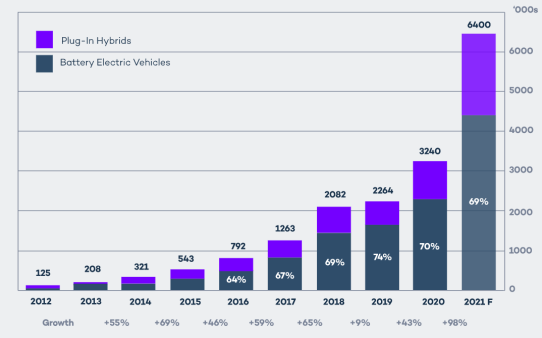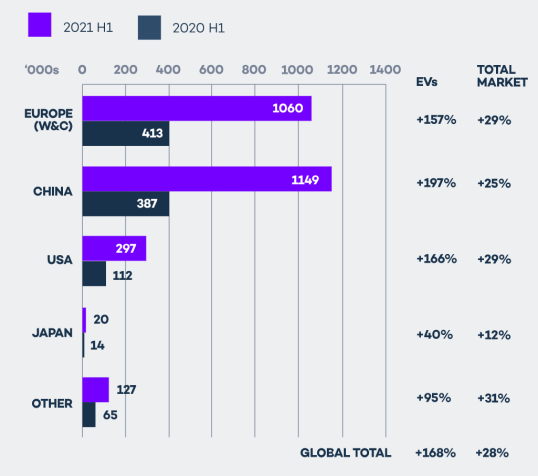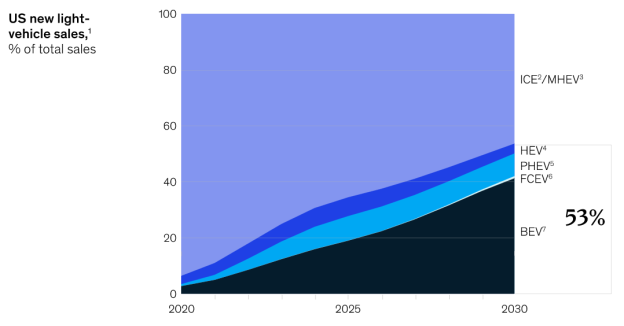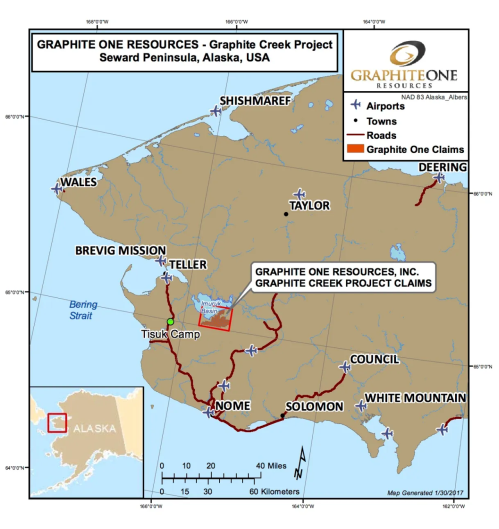
For US to stand a chance in the
global battery arms race, developing a graphite supply is a
must.
In a few years' time, we will
look back at 2021 as the turning point in human history where
vehicle electrification became no longer just a consumer choice,
but a necessary step towards achieving net-zero
emissions.
The recent COP26 climate change
conference served as both a reminder and a "call to action" that
the global transition from gas-powered cars towards plug-in
vehicles is far from complete.
Transportation currently makes up
28% of the global emissions, so the scope for improvement remains
significant.
Of course, the plan of "going
green" and cleaning up the planet requires significant action from
the world's two largest economies, the US and China.
President Biden is already
pushing forward on climate-oriented programs, including the $1.1
trillion infrastructure spending package recently passed by
Congress.
Vehicle electrification is a
major part of the legislation's focus. It would provide $7.5
billion for low-emissions buses and ferries, and aims to deliver
thousands of electric school buses to districts across the country.
Another $7.5 billion is expected to go towards building a
nationwide network of plug-in EV chargers.
This past August, Biden signed an
executive order requiring that half of all US new vehicle sales be
electric by 2030.
China, too, is moving forward
rapidly on its plans to electrify and decarbonize its roads,
looking to make
all new vehicles sold in the country "eco-friendly" by 2035.
China is the world leader in
electric vehicles and battery production.
EV Market
Growth
As expected, the global energy
transition would create strong tailwinds for the EV market for
years and even decades into the future.
Power Technology, known for its
research on the energy sector, reports that EV sales have already
more than doubled worldwide in the first half of 2021, increasing
by 160% compared to H1 2020. The 2.6 million units sold, 1.1
million of which were in China, represent 26% of total new car and
truck sales globally.
An analysis from IDTechEx quoted
by the publication forecasts EV sales in 2021 are on track to
surpass 5 million passenger cars. "If they do, it will mean an astonishing
growth rate of ~86% CAGR since 2011," the report reads.
Virta, which claims to be the
fastest-growing electric vehicle charging platform in Europe,
operating in over 30 countries, is more aggressive in its 2021 EV
sales forecast.

Global plug-in
vehicle sales. Source: Virta

BEV + PHEV
sales and % growth. Credit: Virta
"Carried by a decarbonization
challenge most leading nations now take seriously, 2021 is a game
changer in the history of EV sales and it is expected that 6.4
million vehicles (EVs and PHEVs combined) will be sold globally by
the end of the year. It would then represent a 98% year over year
increase," the company states in a report titled
'The
Global Electric Vehicle Overview in 2022: Statistics and
Forecasts'.
Projecting further out, Virta
cites the International Energy Agency's (IEA) Global EV Outlook
2021, whose Stated
Policies Scenario suggests that by 2030, the global EV stock
(excluding two- and three-wheelers) could reach nearly 145 million
and account for 7% of the total vehicle fleet.
The more ambitious EV30@30
campaign envisions, plainly, 30% of all vehicles becoming electric
by 2030, putting global sales at 43 million, or almost double that
of the Stated Policies Scenario.
It isn't only electric cars and
trucks that are increasing in popularity either. According to
Virta: "From public transportation to e-scooters: The entire
transport industry is turning electric."
For example, in the US, e-bike
sales have more than doubled in 2020, whereas in Europe, electric
scooters are becoming more mainstream. The IEA's
Global EV
Outlook 2021 found more
than 100 European cities have already started operating
e-scooters.
Heavy-duty electric truck
registrations were up 10% in 2020, which is significant considering
that large ICE trucks are responsible for 70% of CO2 emissions.
Electric buses have also been increasing since 2020, with Virta
noting that China registered 78,00 new e-buses in the past year,
adding to a global fleet of 600,000 in 2020.
More impressive EV sales
statistics can be found in a recent report by McKinsey &
Company.
Starting with 2020, the
consultancy notes that global sales exceeded pre-pandemic levels by
the third quarter, with Europe and China achieving fourth-quarter
sales increases of 60% and 80%, respectively, over the previous
quarter, helping to drive global EV penetration to an all-time high
of 6%. (higher than Virta's 4.6%)
McKinsey's numbers only go to the
second quarter of 2021, when it says EV sales in the US increased
by nearly 200% compared to Q2 2020, contributing to a domestic
penetration rate of 3.6% during the pandemic. The next report
should deliver similar or even better growth figures.
McKinsey believes EV sales will
continue increasing, fueled by government policies including the
Biden administration's stated goal that half of all new vehicle
sales by 2030 be zero-emission; state-level adoption of credit
programs; tougher emissions standards; and increasing
electrification commitments from OEMs.

EVs are likely
to account for more than half of all US passenger car sales by
2030, according to McKinsey. Source: McKinsey &
Company
More Battery
Minerals
For all the talk of
electrification, nothing can be achieved without ensuring there is
enough supply of the metals used to power these
vehicles.
A 2020 World Bank report
entitled 'The Mineral Intensity of
the Clean Energy Transition', estimated that production of minerals
underpinning the clean energy shift such as lithium and graphite
would have to increase by nearly 500% by 2050 to meet global demand
for renewable energy.

Cumulative
demand for minerals needed for energy storage through 2050. Source:
World Bank

Projected
annual mineral demand under the 2-Degree Scenario. Source: World
Bank
Obviously these include lithium,
a key ingredient for making EV batteries, which is set to endure an
unprecedented shortage of supply in the coming years. Global miner
Rio Tinto has previously said even if they had another 60 lithium
mines, that wouldn't fill the supply-demand gap.
With EVs expected to take up over
half of the total vehicle sales as early as 2030, that would
require as much as 3 million tonnes of lithium annually, compared
to the 400,000 tonnes of lithium per year being mined
currently.
Even if you combine all existing
operations plus future projects around the world, that's only 1
million tonnes of future lithium, still a 2-million-tonne gap that
needs to be filled. Bloomberg NEF research shows that over five
times more lithium is needed in 2030 compared to current
levels.
Another battery mineral that is
not in the spotlight as much but is also facing severe supply
concerns is graphite. Did you know: Graphite
is the only material that can be used in the lithium-ion battery
anode, there are no substitutes.
According to
the World Bank, graphite accounts for nearly 53.8% of the mineral
demand in batteries, the most of any. Lithium, despite being a
staple across all Li-ion batteries, accounts for only 4% of total
demand.
An average hybrid-gasoline
electric vehicle carries up to 10 kg of graphite, while a plug-in
EV has seven times that amount - around 70 kg.
For every million electric
vehicles, which is only about 1% of the new car market, we need in
the order of 75,000 tonnes of natural graphite, representing a 10%
increase in flake graphite demand.
The EV battery market alone is
projected to consume well over 1.6 million tonnes of flake graphite
per year, resulting in a ten-fold increase in demand by 2030. This
is worrisome considering that total graphite mined in 2020
for all
uses, including lump
graphite for pencils and graphite used in nuclear reactors, was
only 1.1 million tonnes.
It is estimated that the natural
flake graphite market could reach a deficit as soon as 2023, with
few new sources being developed around the world.

Image: Visual
Capitalist
At the moment, nearly all
graphite processing takes place in China because of the ready
availability of graphite there, weak environmental standards and
low costs. Approximately 59% of the world's natural graphite
production
last year came from China, making
it a dominant player in every stage of the supply chain.
Meanwhile the US, despite
boasting a large EV market, has no domestic production, meaning it
has to fully rely on its main economic rival (and its other trading
partners) for battery-grade graphite supply (see below). Such a
level of dependence can be considered both unsustainable and
uneconomical.

Data source:
USGS. Image: Visual Capitalist
This is why the US is not looking
to develop its own "mine to battery" supply chain, which would
include a cost-competitive and environmentally sustainable source
of graphite.
A White House report on critical
supply chains showed that graphite demand for clean energy
applications will require 25 times more graphite by 2040 than was
produced worldwide in 2020.
On February 24, 2021, President
Joe Biden signed an executive order (EO) aimed at strengthening
critical US supply chains. Graphite was specifically identified as
one of four minerals considered essential to the nation's "national
security, foreign policy and economy."
Fortunately, there is plenty of
North American graphite for local consumption, if industry and
government can find the collective will to make it
happen.
As far as we know, the Kigluaik
Mountains on Alaska's Seward Peninsula in Alaska hosts at least one
deposit with the size and grade to meet the nation's growing need
for graphite in Li-ion batteries.
Graphite
One
Earlier this year, the Federal
Permitting Improvement Steering Committee (FPISC) granted
High-Priority Infrastructure Project (HPIP) status to
Graphite One
Inc. (TSXV:GPH, OTCQX:GPHOF), which is aiming to develop America's first
high-grade producer of coated spherical graphite (CSG) integrated
with a domestic graphite resource at Graphite Creek,
Alaska.
The HPIP designation allows
Graphite One to list on the US government's Federal Permitting
Dashboard, which ensures that the various federal permitting
agencies coordinate their reviews of projects as a means of
streamlining the approval process.
Graphite Creek is the
highest-grade and largest known flake graphite deposit in North
America, spanning a distance of 18 km.

The Graphite
Creek property is located 55 km north of Nome, Alaska
The project is envisioned as a
vertically integrated enterprise to mine, process and manufacture
high-quality CSG for the lithium-ion electric vehicle battery
market. Graphite One aims to become the first US vertically
integrated domestic producer to do so.
The latest resource estimate
(March 2019) for Graphite Creek showed 10.95 million tonnes of
measured and indicated resources at a graphite grade of 7.8% Cg
(graphitic carbon), for some 850,000 tonnes of contained graphite.
Another 91.9 million tonnes were tagged as inferred resources, with
an average grade of 8.0% Cg containing 7.3 million
tonnes.
A Preliminary
Economic Assessment (PEA) supports a 40-year operation with a
mineral processing plant capable of producing 60,000 tonnes of
graphite concentrate (at 95% purity) per year. On a pre-tax basis, the project has a net
present value of $1.03 billion using a 10% discount rate, with an
internal rate of return (IRR) of 27%.
Once in full
production, Graphite One's proposed graphite products manufacturing
plant — the second link in its proposed supply chain strategy — is
expected to turn graphite concentrates into 41,850 tonnes of
battery-grade coated spherical graphite and 13,500 tonnes of
graphite powders per year. A location in the Pacific Northwest is being
considered.
Graphite Creek
Field Program
Last month, Graphite One reached
a significant milestone in its project development with the
completion of the 2021 field program at Graphite Creek.
The field program included infill
and step-out core drilling in the resource area, plus additional
core and sonic drilling for geotechnical data collection in the
proposed mill site and dry tailings/waste rock storage
areas.
Other work included access route
engineering, surface water and groundwater hydrology studies,
wetlands mapping and aquatic life surveys.
A total of 2,052 meters were
drilled during the 2021 program including 1,695 meters of HQ core
drilling and 357 meters of sonic drilling. Results from 8 core
holes completed in the resource area are expected to be released in
Q1 2022.
According to Graphite One, the
2021 core drilling in the deposit area continued to encounter
visible graphitic mineralization over wide intervals that are
consistent with previous drilling results, as reported in 2019 and
in the 2017 PEA.
Additional core drilling was
completed to collect detailed geotechnical information for open-pit
and mills site engineering, and for groundwater
investigations.
The 5 sonic holes completed in
the dry tailings/waste rock storage area will provide detailed
geotechnical information to advance the engineering of these
facilities, the company says.
Overall, this drill program will
generate additional information to update the resource model and
provide technical data for the project's Feasibility Study (FS),
expected to be initiated in 2022.
Meanwhile, the Preliminary
Feasibility Study (PFS) is progressing and scheduled for release
later this year.
"With the recent C$21 million in
funding, our efforts have progressed towards completion of the PFS
for the largest known and highest-grade graphite deposit in the
United States," Anthony Huston, CEO of Graphite One, stated in the
Oct. 13 news release.
"We are very pleased with the
successful execution of the 2021 field program, as historical
drilling coupled with the new data clearly demonstrates the
predictability and consistency of high-grade, near-surface
graphite.
"With the concepts and
conclusions outlined in the PEA suggesting a 40-year mine life, the
Graphite Creek deposit continues to show potential to be an
essential long-life component of the graphite supply chain, one of
four critical minerals that are on the US National Defense
stockpile list."
While the PEA demonstrated the
project's economic viability, the company expects these further
studies, with their optimized plans for the mine and processing
facilities, to further improve the economics.
Conclusion
With US President Joe Biden
finally putting pen to paper on the $550 billion bipartisan
infrastructure bill, the American EV revolution is now moving at
full throttle. It's almost certain that by 2030, electric-powered
vehicles will dominate the US roads.
However, this could only
materialize once there is a reliable and sufficient supply of
metals used to build EV batteries. The fact that a mineral like
graphite, which has no substitutes in a battery anode, has always
been imported by the US raises alarms for the future state of the
industry.
Placing graphite among the list
of critical minerals was a good start, and with the slew of
investments to "electrify" the economy and get the nation closer to
its end-of-decade climate goals, that spells opportunity to
prospective mine developers.
Graphite One is a company on the
move with the largest and highest-grade flake graphite deposit in
the United States.
What it has discovered so far
though is only a small portion of the geological trend under
consideration. I believe Graphite Creek will become a mine and that
its production will supply a large percentage of US domestic
graphite demand. I therefore see it as an important link in
America's burgeoning "mine to battery" supply chain.
Graphite One
Inc.
TSXV:GPH, OTCQX:GPHOF
Cdn$2.04, 2021.11.23
Shares Outstanding
83.3m
Market cap Cdn$170m
GPH website
Richard (Rick) Mills
aheadoftheherd.com
subscribe
to my free newsletter
Legal Notice /
Disclaimer
Ahead of the Herd newsletter,
aheadoftheherd.com, hereafter known as AOTH.
Please read the entire Disclaimer
carefully before you use this website or read the newsletter. If
you do not agree to all the AOTH/Richard Mills Disclaimer, do not
access/read this website/newsletter/article, or any of its pages.
By reading/using this AOTH/Richard Mills
website/newsletter/article, and whether you actually read this
Disclaimer, you are deemed to have accepted it.
Any AOTH/Richard Mills document
is not, and should not be, construed as an offer to sell or the
solicitation of an offer to purchase or subscribe for any
investment.
AOTH/Richard Mills has based this
document on information obtained from sources he believes to be
reliable, but which has not been independently verified.
AOTH/Richard Mills makes no
guarantee, representation or warranty and accepts no responsibility
or liability as to its accuracy or completeness.
Expressions of opinion are those
of AOTH/Richard Mills only and are subject to change without
notice.
AOTH/Richard Mills assumes no
warranty, liability or guarantee for the current relevance,
correctness or completeness of any information provided within this
Report and will not be held liable for the consequence of reliance
upon any opinion or statement contained herein or any
omission.
Furthermore, AOTH/Richard Mills
assumes no liability for any direct or indirect loss or damage for
lost profit, which you may incur as a result of the use and
existence of the information provided within this AOTH/Richard
Mills Report.
You agree that by reading
AOTH/Richard Mills articles, you are acting at your OWN RISK. In no
event should AOTH/Richard Mills liable for any direct or indirect
trading losses caused by any information contained in AOTH/Richard
Mills articles. Information in AOTH/Richard Mills articles is not
an offer to sell or a solicitation of an offer to buy any security.
AOTH/Richard Mills is not suggesting the transacting of any
financial instruments.
Our publications are not a
recommendation to buy or sell a security - no information posted on
this site is to be considered investment advice or a recommendation
to do anything involving finance or money aside from performing
your own due diligence and consulting with your personal registered
broker/financial advisor.
AOTH/Richard Mills recommends
that before investing in any securities, you consult with a
professional financial planner or advisor, and that you should
conduct a complete and independent investigation before investing
in any security after prudent consideration of all pertinent
risks. Ahead of the Herd is not a registered broker,
dealer, analyst, or advisor. We hold no investment licenses and may
not sell, offer to sell, or offer to buy any security.
Richard owns shares of Graphite
One Inc. (TSXV:GPH). GPH is a paid advertiser on his site
aheadoftheherd.com

